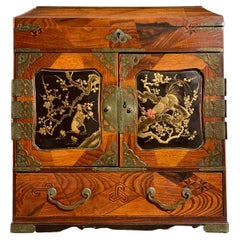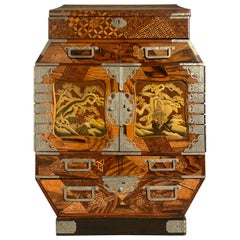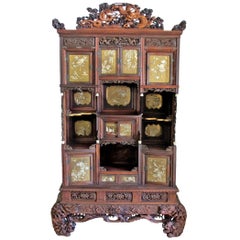Marquetry Lacquer
2
to
2
2
2
2
1
1
1
1
2
2
1
1
1
2
2
2
Technique: Marquetry
Japanese Marquetry and Lacquer Jewelry Chest, Meiji Period, circa 1900, Japan
Located in Austin, TX
A very attractive Japanese wood table top jewelry or collector's chest with marquetry and lacquer decoration, Meiji period, circa 1900, Japan. Previously in the collection of Asbjorn Lunde (1927 - 2017).
The chest is crafted in the form of a Chinese seal...
Category
Early 1900s Japanese Meiji Antique Marquetry Lacquer
Materials
Wood, Softwood, Lacquer
Large Japanese Marquetry Table Cabinet, Meiji Period, Late 19th Century, Japan
Located in Austin, TX
A fine and unusually large Japanese table cabinet or jewelry chest with yosegi marquetry work and lacquer paneled doors, Meiji period, late 19th century, Japan.
The oversized tab...
Category
1890s Japanese Meiji Antique Marquetry Lacquer
Materials
Brass
Related Items
Japanese Carved and Lacquered Shibayama Cabinet, Meiji Period
Located in San Francisco, CA
An elaborate and finely detailed carved wood, and gold lacquered Shibayama cabinet (Chigaidansu). Having beautifully applied semi-precious stone and ...
Category
19th Century Japanese Meiji Antique Marquetry Lacquer
Materials
Mother-of-Pearl, Wood
Lacquer Table, Late Meiji Period, Japan, circa 1900
Located in Buenos Aires, Buenos Aires
Lacquer table, Art Deco period, Japan, circa 1900.
Category
Early 1900s Japanese Art Deco Antique Marquetry Lacquer
Materials
Lacquer
Signed Japanese White Lacquer and Maki-E Lacquer Tansu, Meiji Period
Located in Ottawa, Ontario
The case decorated overall in crackle-glaze white lacquer and fitted with a patinated metal carrying handle over three tiers of small drawers. The first two tiers are comprised of a ...
Category
Late 19th Century Japanese Meiji Antique Marquetry Lacquer
Materials
Lacquer
Japanese Antique "Staircase Chest" 'Late Edo Period-Meiji Period' /Cabinet
Located in Sammu-shi, Chiba
We have an aesthetic sense peculiar to Japanese people.
And we introduce the unique items that only we can do, the route of purchasing in Japan, the experience value so far, and the way that no one can imitate.
Japanese antique black chest "staircase chest...
Category
19th Century Japanese Edo Antique Marquetry Lacquer
Materials
Cedar
H 22.64 in W 13.78 in D 23.63 in
Japanese Lacquer Box with Fine Maki-e Decoration Meiji Period
Located in Atlanta, GA
A lacquered wood box with lid from Japan circa 19th century Meiji Period. The finely decorated box was used to store paper slips and small documents on the desk. It is overall finished with black lacquer (kuro) with sparse Mura-Nashiji effect outside and on the top surface of the lid, there are three Komainu, (sometimes known as Shishi or Japanese lions) frolicking and forming a circle in lively motion. Komainu are auspicious animals in Japanese cultures in both Shinto and Buddhism tradition. Originally from China, these animals symbolizes guardians to ward off evil spirits. Hiramaki-e was used in combination with carving and combing to render the lions with various surface textures. A gilt border with an slight angle was given to the lid and even the thin band is decorated with miniature floral scrolls. The interior of the box was finished in a dense nashiji. Underneath the lid, a cluster of peonies open lavishly by two gentle mounts. Takamaki-e (high relief) in both gold and silver were...
Category
Late 19th Century Japanese Japonisme Antique Marquetry Lacquer
Materials
Wood, Lacquer
Japanese Laquered Box with Hinged Lid hand painted, 19th Century Meiji Period
Located in Lincoln, Lincolnshire
This is a good papier mâché, rectangular shaped black lacquered lidded box, hand enamelled and gilded, made in Japan during the 19th century, early Meiji period.
This rectangular shaped papier mâché box has a well fitting hinged lid, with the box base and lid slightly domed. The box was probably originally made as a pocket box but could easily sit on a desk or dressing table as required.
This is a very decorative box with finely hand painted scenes of three people, one holding a parasol, in a garden setting, with a pagoda type building, large gate...
Category
19th Century Japanese Meiji Antique Marquetry Lacquer
Materials
Paper
H 1.38 in W 3 in D 2.13 in
Rare Charming 17th Century Japanese Lacquer Cabinet with Gilt-Bronze Mounts
Located in Amsterdam, NL
A fine Japanese pictoral style lacquer cabinet with gilt-metal mounts
Kyoto, Edo period, 1670-1690
Decorated in Japanese relief lacquer work, black lacquer ground decorated...
Category
Late 17th Century Japanese Antique Marquetry Lacquer
Materials
Bronze
Free Shipping
H 23.82 in W 24.02 in D 18.31 in
Japanese Tansu Storage Cabinet with Sliding Doors, Meiji Period, 19th Century
Located in Savannah, GA
Large Two Section Japanese Kitchen Tansu, Late 19th Century. Interior bottom section has been modified to accommodate a TV. Part of the back bot...
Category
Late 19th Century Japanese Meiji Antique Marquetry Lacquer
Materials
Elm
H 66.25 in W 47.5 in D 18.75 in
Japanese Meiji Period Antique Lacquer Box with Gold Maki-e Decoration
Located in New York, NY
A fine antique Japanese Meji Period lacquer box decorated with a fan and a stylized star shaped window in the maki-e technique. The fan at the top right corner, fully opened depictin...
Category
19th Century Japanese Meiji Antique Marquetry Lacquer
Materials
Lacquer
Small Japanese Marquetry Cabinet Yosegi Zaiku 19th Century
Located in Beuzevillette, FR
Very beautiful Japanese jewelry cabinet in Yosegi-zaiku marquetry composed of six drawers. The whole is inlaid with geometrically shaped pieces of wood and decorated with motifs resembling kamon...
Category
19th Century Japanese Antique Marquetry Lacquer
Materials
Wood
Rare Japanese Sumi-E Lacquer Inro Yamada Jokasai Edo Period
Located in Atlanta, GA
A three-case lacquered Inro by Yamada Family circa 18th-19th century Edo period. The inro with slight rounded form is of Kano style and vividly depicts a dragon slithering among the ink clouds on a gold background. Sumi-e togidashi (ink togidashi) technique, in combination with Hiramaki-e, were employed to create the dreamy ambience of this piece. The dragon has a painterly appearance inspired by Chinese ink painting that was often seen on the Japanese folding screens. The back of the Inro was sparsely decorated with the shifting patterns of the darkening clouds with an emphasis on the space intentionally left empty. Jokasai was signed to the base. On the front of the inro there is another miniature signature Hakugyoku Hogen, which is one of names used by Kano Michinobu (1730-1790). The dragon is evidently one of his designs (see reference below).
Established by a member of Yamada family in the 17th century, the clan was one of the most prominent lacquer artisanal family for the next 200 years until the end of Edo period in the 19th century. Most members signed their work simply with Jokasai making the identification of the individual artists somewhat impossible. The current Inro on offer, compared to many other pieces by Jokasai, has an uncommon Kano style done in Sumi-e togidashi.
Another unusual feature of this piece is that the interiors of the inro was decorated with an interesting gold mosaic inlays (kirigane) on a dark lacquer background, giving it a jewel like quality.
For another Inro by Jokasai of a similar style using Sumi-e togidashi but depicts a tiger, see Wrangham collection, no.353, which was offered for sale as lot 256 in Bonham's London Auction: The Edward Wrangham Collection of Japanese Art Part I. 9 Nov 2010.
For an ink scroll...
Category
18th Century Japanese Japonisme Antique Marquetry Lacquer
Materials
Wood, Lacquer
Japanese Lacquered Gold Maki-E Naga Fubako Meiji Period
Located in Atlanta, GA
A Japanese lacquered wood Naga Fubako (a long box used to store document or large scroll painting), circa 19th century Meiji period. The rectangular box features an unusually deep lipped lid with slightly rounded corners, a conforming lower box with bronze medallion rings with tasseled...
Category
19th Century Japanese Meiji Antique Marquetry Lacquer
Materials
Wood, Lacquer
Recently Viewed
View AllMore Ways To Browse
Antique Silver Trays Tray Asia
Korean Pearl
Maki Vintage
Maki Maki Vintage
Chinese Antique Cinnabar
Japanese Lacquer Ware
Chinese Carved Cinnabar Red Lacquer
Antique Japanese Lacquerware
Inro Japan
Japanese Lacquered Trunk
Korean Mother Of Pearl Furniture
Chinese Lacquer Fan
Korean Mother Of Pearl
Offering Vessel Lacquer
Lacquer Offering Vessel
Cinnabar Vintage
Japanese Inro
Gold Lacquer Bowl



